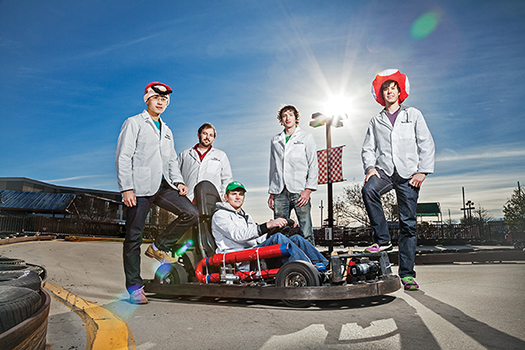

We may earn revenue from the products available on this page and participate in affiliate programs. Learn more ›
One summer, a young engineer walked into Austin’s Park, an amusement center outside the Texas capital, and introduced himself to the manager as an intern from Waterloo Labs—a hacking collaborative sponsored by the engineering juggernaut National Instruments. He and his colleagues wanted to convert the go-kart track into a real-life, crash-happy version of the classic videogame series Mario Kart. The manager didn’t just agree. He lent him a kart.
In Super Mario Kart, cartoon drivers zoom around a track littered with interactive objects. Some boost a player’s speed, others hijack steering, and many can be launched at competitors. Four interns at Waterloo Labs grew up playing the game, so when someone suggested making a real-world version, they couldn’t resist. “We weren’t entirely sure how we were going to do it,” says intern Tim Lynch, “but we said, ‘Okay, we need to do this.’?”
Re-creating the game’s interactivity meant that objects on the track had to communicate with speeding go-karts. At first, the team thought of using passive, close-range radio-frequency identification (RFID) tags. The interns tested that idea by tossing their ID cards at a security scanner to see whether the embedded chips transmitted a signal fast enough. “That didn’t work,” says Humphrey Huang. Next, they tried an active, self-powered RFID system. It cost an extra $500 but could transmit signals as far as 30 feet away, allowing each kart to interact with objects via its own RFID reader.
The interns’ biggest hurdle: overriding the kart’s controls. “We needed to be able to fight against someone trying to turn the wheel,” says Lynch. They eventually selected powerful pneumatic pistons, which they attached to the chassis using zip ties, duct tape, and braces. When a driver captured or collided with an item, a reader would send that item’s unique ID to the computer, which, in turn, ordered pistons, valves, or servomotors to swerve, stop, or speed up the kart [see “How It Works,” next page].
They tested the hacked kart in the park’s garage, tossing plush toys embedded with RFID tags at the vehicle and watching it respond like a living creature. Then—with the track manager’s approval—they modified three other racers and added pneumatic cannons so that drivers could fire kart-crippling toys at competitors.
On game day, Huang, Lynch, Dylan Caswell, and Peter Gaylor raced, crashed, and futilely tried to prevent their carts from careening into the railing when RFID-tagged toys took over the controls. Lynch learned to steer with his knees while grabbing objects from the track and loading them into his cannon. Huang shot a plush turtle shell across the track at Caswell, triggering the RFID system in his kart and jamming the brakes. “We were doing lap after lap and thinking, ‘It’s actually working,’?” says Lynch. “?’We’re actually playing Mario Kart.’?”
“LET’S-A-GO!”

The red shell slows down a driver and jams steering. Air pistons attached to the front wheel’s tie rods lock it in place, while another piston depresses the brake pedal.

A driver who captures a green shell can stuff it into an air cannon and then launch it toward an opponent to fully stop his kart.

Plastic bananas cause one tie-rod piston to contract and another to expand, forcing the front wheels to the right on the left-aiming track. “We figured that would be most perilous,” says Hunter Smith, Waterloo Labs’ internship coordinator.

Normally, a spring prevents the throttle lever from opening more than 85 percent. The RFID tag in the plush mushroom, however, triggers a servomotor to pull on the lever—enabling the driver to reach speeds nearing 35 mph.

The lucky driver who grabs a plush star temporarily earns a fully opened throttle, while his Wi-Fi–equipped controller orders all other karts to brake.
(Get the specifics of the project on the next page)

HOW IT WORKS
Hacking go-karts into the racecars of the Mario Kart videogame series was no simple feat. Four interns from Waterloo Labs began with standard four-stroke-engine vehicles and added components such as ruggedized cRIO computer controllers, Wi-Fi routers, and RFID readers.
1) TOY CANNON
Compressed air fed into a PVC pipe can blast a plush toy at competitors as far as 30 feet away.
2) FASTENERS
Zip ties, brackets, and other removable hardware made all modifications reversible.
3) AIR TANKS
A 3,000psi paintball tank stores 48 cubic inches of air to charge add-on pistons.
4) ELECTRONICS
A suite of gadgets can detect the RFID codes of objects on the track and then control the kart.
5) STEERING
A 130psi air piston attached to each tie rod can steer a kart off-course.
6) BRAKE OVERRIDE
A valve can depress the brake pedal by directing high-pressure air into a piston.
Time: 8 weeks
Cost: $1,200
WARNING: We review all our projects before publishing them, but ultimately your safety is your responsibility. Always wear protective gear, take proper safety precautions, and follow all laws and regulations.
This article originally appeared in the May 2013 issue of Popular Science. See the rest of the magazine here.
